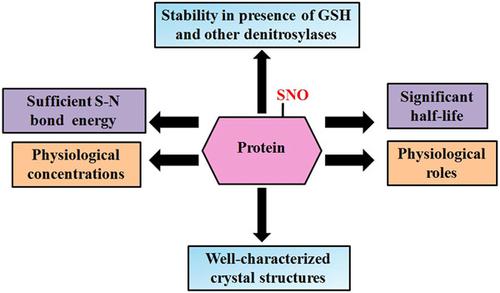当前位置:
X-MOL 学术
›
J. Cell. Biochem.
›
论文详情
Our official English website, www.x-mol.net, welcomes your
feedback! (Note: you will need to create a separate account there.)
Stability of S-nitrosothiols and S-nitrosylated proteins: A struggle for cellular existence!
Journal of Cellular Biochemistry ( IF 3.0 ) Pub Date : 2021-09-01 , DOI: 10.1002/jcb.30139 Ajanta Chatterji 1 , Rajib Sengupta 1
Journal of Cellular Biochemistry ( IF 3.0 ) Pub Date : 2021-09-01 , DOI: 10.1002/jcb.30139 Ajanta Chatterji 1 , Rajib Sengupta 1
Affiliation

|
Nitric oxide is a well-known gasotransmitter molecule that covalently docks to sulfhydryl groups of proteins resulting in S-nitrosylation of proteins and nonprotein thiols that serve a variety of cellular processes including cGMP signaling, vasodilatation, neurotransmission, ion-channel modulation, and cardiac signaling. S-nitrosylation is an indispensable modification like phosphorylation that directly regulates the functionality of numerous proteins. However, recently there has been a controversy over the stability of S-nitrosylated proteins (PSNOs) within the cell. It has been argued that PSNOs formed within the cell is a transient intermediate step to more stable disulfide formation and disulfides are the predominant end effector modifications in NO-mediated signaling. The present article accumulates state-of-the-art evidence from numerous research that strongly supports the very existence of PSNOs within the cell and attempts to put an end to the controversy. This review illustrates critical points including comparative bond dissociation energies of S-NO bond, the half-life of S-nitrosothiols and PSNOs, cellular concentrations of PSNOs, X ray crystallographic studies on PSNOs, and stability of PSNOs at physiological concentration of antioxidants. These logical evidence cumulatively support the endogenous stability and inevitable existence of PSNOs/RSNOs within the cell that directly regulate the functionality of proteins and provide valuable insight into understanding stable S-nitrosylation mediated cell signaling.
中文翻译:

S-亚硝基硫醇和 S-亚硝基化蛋白质的稳定性:细胞生存的斗争!
一氧化氮是一种众所周知的气体递质分子,它与蛋白质的巯基共价对接,导致蛋白质和非蛋白质硫醇的 S-亚硝基化,服务于各种细胞过程,包括 cGMP 信号传导、血管舒张、神经传递、离子通道调节和心脏信号传导. S-亚硝基化是一种不可或缺的修饰,如磷酸化,可直接调节多种蛋白质的功能。然而,最近对细胞内 S-亚硝基化蛋白 (PSNO) 的稳定性存在争议。有人认为,在细胞内形成的 PSNO 是更稳定的二硫化物形成的短暂中间步骤,二硫化物是 NO 介导的信号传导中主要的末端效应修饰。本文从众多研究中积累了最先进的证据,这些证据强烈支持细胞内 PSNO 的存在,并试图结束争议。本综述阐述了关键点,包括 S-NO 键的比较键解离能、S-亚硝基硫醇和 PSNOs 的半衰期、PSNOs 的细胞浓度、PSNOs 的 X 射线晶体学研究以及 PSNOs 在抗氧化剂生理浓度下的稳定性。这些合乎逻辑的证据累积支持细胞内 PSNO/RSNO 的内源稳定性和不可避免的存在,它们直接调节蛋白质的功能,并为理解稳定的 S-亚硝基化介导的细胞信号传导提供有价值的见解。
更新日期:2021-10-29
中文翻译:

S-亚硝基硫醇和 S-亚硝基化蛋白质的稳定性:细胞生存的斗争!
一氧化氮是一种众所周知的气体递质分子,它与蛋白质的巯基共价对接,导致蛋白质和非蛋白质硫醇的 S-亚硝基化,服务于各种细胞过程,包括 cGMP 信号传导、血管舒张、神经传递、离子通道调节和心脏信号传导. S-亚硝基化是一种不可或缺的修饰,如磷酸化,可直接调节多种蛋白质的功能。然而,最近对细胞内 S-亚硝基化蛋白 (PSNO) 的稳定性存在争议。有人认为,在细胞内形成的 PSNO 是更稳定的二硫化物形成的短暂中间步骤,二硫化物是 NO 介导的信号传导中主要的末端效应修饰。本文从众多研究中积累了最先进的证据,这些证据强烈支持细胞内 PSNO 的存在,并试图结束争议。本综述阐述了关键点,包括 S-NO 键的比较键解离能、S-亚硝基硫醇和 PSNOs 的半衰期、PSNOs 的细胞浓度、PSNOs 的 X 射线晶体学研究以及 PSNOs 在抗氧化剂生理浓度下的稳定性。这些合乎逻辑的证据累积支持细胞内 PSNO/RSNO 的内源稳定性和不可避免的存在,它们直接调节蛋白质的功能,并为理解稳定的 S-亚硝基化介导的细胞信号传导提供有价值的见解。










































 京公网安备 11010802027423号
京公网安备 11010802027423号